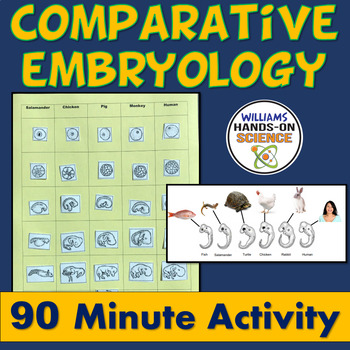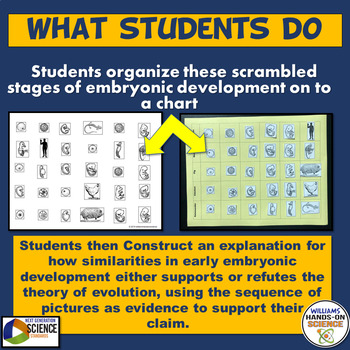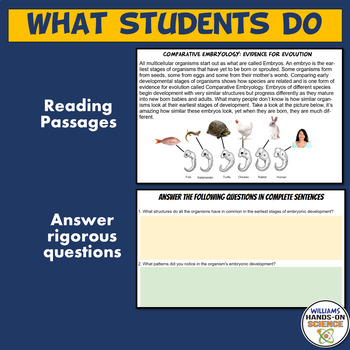Comparative Embryology NGSS LS4.A MS-LS4-3 Card Sort CER Reading
- Zip
Description
Students are wowed by this 90 minute Comparative Embryology card sort, reading passages, questions and CER activity!
If you are teaching NGSS Performance Expectation MS-LS4-3 Analyze displays of pictorial data to compare patterns of similarities in the embryological development across multiple species to identify relationships not evident in the fully formed anatomy, this resource is perfect for you!
Students attempt to organize random cards of different stages of embryonic development of a human, monkey, pig, chicken and salamander. When students finish their first attempt, they read the close reading and have a class discuss. Then you as the teacher show the students the key, they rearrange the cards correctly and the students then answer rigorous questions that hit the Performance Expectation MS-LS4-3, “Construct an explanation for how similarities in early embryonic development either supports or refutes the theory of evolution, using the sequence of pictures as evidence to support your claim. First state your claim of whether it supports or refutes evolution. Then use evidence from the pictures to support your claim in the form of a paragraph.” This is great for meta-cognition, critical thinking and rich class discussions.
This resource also includes a current article where students learn how Tiny 'Lizard-Like' Muscles Found in Developing Human Embryos Vanish Before Birth through a C.E.R. (Claim Evidence Reasoning) graphic organizer. This is great for getting your students to explain phenomena in a meaningful way and it allows you as the instructor to adequately assess their understanding of concepts. The students figure out what the "Claim" is in the article, they then use data that supports the claim in the "Evidence" section, draw visual evidence and then explain why the evidence supports the claim in the "Reasoning" section. It directly relates to the card sort to reinforce and extend Comparative Embryology!
The resource has the following concepts:
Comparative Embryology
Evolution
Embryological Development
Common Ancestors
Multicellular Organisms
Embryos
Species
Vertebrate
Patterns
Relationships
Hominid
Mammal-like Reptiles
Fetal Muscle Development
Anatomical structures
This resource is approximately 90 minutes if you use the card sort and CER article.
This product Includes the following:
-Student Handout
-Embryonic Stages Cards
-Chart to organize Cards on
-Smaller chart for note booking
-Comparative Embryology Close Reading
-Key for the chart and questions
-Detailed Teacher Notes
-CER Article on Lizard-Like Muscles Found in Human Embryos with CER Graphic Organizer
-Google Classroom directions for Distance Learning
-Google Classroom Tutorials
NGSS Standards
Performance Expectations:
Natural Selection and Adaptations- Analyze displays of pictorial data to compare patterns of similarities in the embryological development across multiple species to identify relationships not evident in the fully formed anatomy. MS-LS4-3
Disciplinary Core Ideas:
LS4.A: Evidence of Common Ancestry and Diversity- Comparison of the embryological development of different species also reveals similarities that show relationships not evident in the fully-formed anatomy. MS-LS4-3
Science and Engineering Practices:
Analyzing and Interpreting Data- Analyze displays of data to identify linear and nonlinear relationships. MS-LS4-3 Analyze and interpret data to determine similarities and differences in findings. MS-LS4-1
Cross Cutting Concepts:
Patterns- Graphs, charts, and images can be used to identify patterns in data. MS-LS4-1, MS-LS4-3 Patterns can be used to identify cause-and-effect relationships. MS-LS4-2
If there are any errors or questions, please contact me through TpT or email me at:
williamshandsonscience@gmail.com
TERMS OF USE
• All rights reserved by Williams Hands On Science, Inc.
• This product is to be used by the original purchaser only.
• Intended for classroom and personal use only.
• Copying for more than one teacher, classroom, department, school, or school system is prohibited.
• This product may not be distributed or displayed digitally for public view.
• Failure to comply is a copyright infringement and a violation of the Digital Millennium Copyright Act (DMCA).
If there are any errors or questions, please contact me through TpT or email me at:
williamshandsonscience@gmail.com
Thank you for taking a look!
Please follow me on TpT for new products and check me out on Instagram for my products in action!
https://www.instagram.com/williams_hands_on_science/
Related Products
⭐ 6th 7th or 8th Grade NGSS Genetic Variation/Growth and Development of Organisms
⭐ Claim Evidence Reasoning ESS1.C History of Earth Permian Triassic Extinction
⭐ Claim Evidence Reasoning Human Evolution MS-LS4-1 HS-LS4-2 HS-LS4-1 MS-LS4-2
⭐ Claim Evidence Reasoning Plate Tectonics Pangaea Article and Graphic Organizer
⭐ Claim Evidence Reasoning: Evidence from Oldest DNA Shows Common Ancestry
⭐ MS-LS4-1: NGSS Geologic Time Scale Card Sort
⭐ NGSS 5E Natural Selection Computer Simulation
⭐ NGSS Claim Evidence Reasoning (CER) Oldest Evidence of Life on Land Found
⭐ NGSS Claim Evidence Reasoning: Proof That Earth Is in Its 6th Mass Extinction
⭐ NGSS LS3.A LS3.B Inheritance & Variation of Traits PowerPoint Google Slides
⭐ NGSS LS4.B: Natural Selection and LS4.C: Adaptations Video & Guided Questions
⭐ NGSS Mysterious New Form of DNA Claim Evidence Reasoning Graphic Organizer





